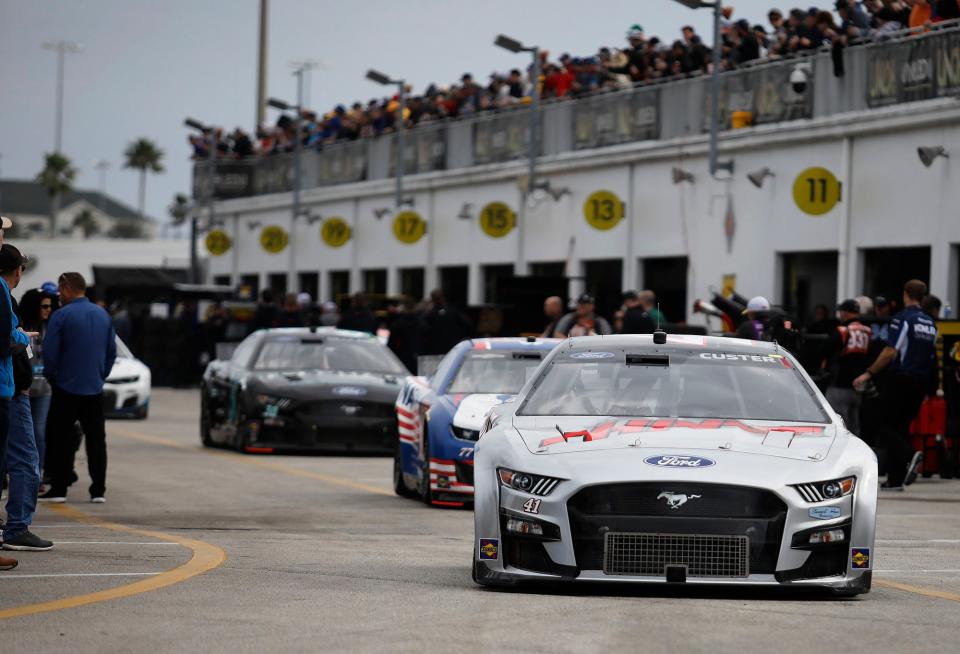Daytona 500, by NASCAR design, has become the "Greatest" American Race
DAYTONA BEACH — You’ve come to recognize the outsized nature of the Daytona 500.
It will be on full display leading up to Sunday afternoon’s 3:06 green-flagging of the 64th Great American Race.
How it got so hell-on-wheels huge can actually be answered by why it got so big and important: Because they wanted it this way.
They? NASCAR’s ruling France family, for starters, dating back a few generations, and by extension all of those they’ve deputized and assigned rather specific marching orders.
A billion-dollar TV deal helps.
WHO'S DICK FREEMAN?: This former Ohio NASCAR driver holds an unbreakable Daytona 500 'record.' Here's what he did
NEW POSITION: 'Learn from the best:' NFL legend Emmitt Smith ready to begin Xfinity team-owner duties at Daytona
NEW GIG: Jeff Gordon returns to Daytona 500 in a new role ... "I've got a real job"

Sitting through a quick history lesson will aid the effort here.
In May of 1954, NASCAR founder and president Bill France Sr. went to Indianapolis during the run-up to the Indy 500, and was escorted out of the famous speedway by security.
Game on!
The Indy 500 was sanctioned and managed by AAA, way back when AAA had a racing division. AAA’s racing efforts included a stock-car series, which obviously rivaled the upstart NASCAR.
Over time, NASCAR won the stock-car war but continued to be viewed as “hillbillies racing taxi cabs” by the high-browed Indy-car set (yeah, yeah, “high-browed Hoosiers” rings of oxymoron, but it was all relative back then).
The obvious thaw came in the early-’90s when Indy’s third generation and NASCAR’s second saw the mutual benefits ($$$) of a NASCAR race at Indianapolis Motor Speedway. Oh, the humanity! To hear some of the Midwest howls, you would’ve thought they were paving the soybean fields.

That partnership is roughly three decades old now, but in its early years there was an unspoken yet unmistakable desire pouring from Bill France Jr.: Yes, NASCAR had finally surpassed Indy-style racing in terms of national popularity, but the final blow would be the Daytona 500 — the family’s prize possession — supplanting the Indianapolis 500 as, dare we say it, the Greatest Spectacle in Racing.
In reality, if not copyrighted verbiage, the Daytona 500 has surpassed Indy in the most important measurable — Daytona’s TV viewer numbers are well off their highs of 10-20 years ago, but still comfortably bigger than Indy’s.
This wasn’t mere happenstance or fully related to IndyCar’s self-inflicted wounds in the late 20th Century.
It was roughly 20 years ago, at a reception of some sort, when Bill France Jr. was listening to gushing reviews of the media operation at Indianapolis and how those folks overwhelm attending media with information and creature comforts. He pressed for more details.
It wasn’t long before a noticeable uptick took place at Daytona, and that effort ran parallel to so many other upgrades, culminating in the “Daytona Rising” rebuild between mid-2013 and early-2016.
The industry-wide lifting of the Daytona 500, fueled in part by marketing teams and in large part by Fox Sports, was already at high-rev but found another gear over the past decade, as the Sunday of the 500 has become the place to be — not just for fans, traditionalists and assorted socialites, but a Who’s Who of politicians, athletes and celebrity show-folk.
The Great American Race would become a Greater American Race, and depending on whether your racing allegiance leans toward fenders or open-wheel, it became the Greatest American Race.
This year's race-day roster includes a pair of big-time Nashville crooners, a former Heisman Trophy winner, a rasslin’ star, international media mogul, automotive industry heavyweights, and an assortment of Fortune 400 suits.
For a while, maybe even a couple of hours, the actual race can feel secondary to it all. Often, there’s a hunk of the afternoon when the the lap after lap after lap becomes a bed of background music.
But eventually they hit the 150-lap mark of the 200-lapper, and you start to see it. Can’t miss it, really. Drivers who appeared to be on a milk-and-bread run begin stepping into the passing lane, sneaking a look and pondering the quickest route to greatness.
Then the rich mix of anxiety and intensity finds another level, then another, and right about when the flag man looks down to make sure the checkers are within reach, every driver on the lead lap begins acting like Richard Simmons in an apartment fire.
When that boiling pot is moved off the burner and everyone begins breathing again, one man stands tallest. Sometimes, it’s a driver we hardly know — a racer who benefits from the field-equalizing horsepower rules at Daytona and sister track Talladega. A driver who, quite honestly, can’t win elsewhere on tracks where the Haves exploit their ample advantages.
It happened last year when Michael McDowell’s racing biography changed forever. Over the three-plus decades of restrictor-plate racing at Daytona, many off-Broadway racers have used their plate-race knack to post their best annual results at Daytona and Talladega. McDowell is among them.
Find the leaders in the late laps, as McDowell did a year ago, and you might just right-place/right-time yourself into racing immortality.
Might sound odd — such a career-defining afternoon can hinge so much on a timely break. But the little placards on that famed Harley J. Earl Trophy only have room for who, not how.
And the “Who” is feted as conqueror of racing’s greatest annual battle, like a swaggering Alexander returning to Macedonia.
Why? All together now: Because they want it this way.
Daytona 500
Tickets: Sold out.
TV: Fox coverage begins at 2:30 p.m.
Green Flag: 3:06 p.m.
This article originally appeared on The Daytona Beach News-Journal: DAYTONA 500: Buckle up for the Great(est) American Race | KEN WILLIS

